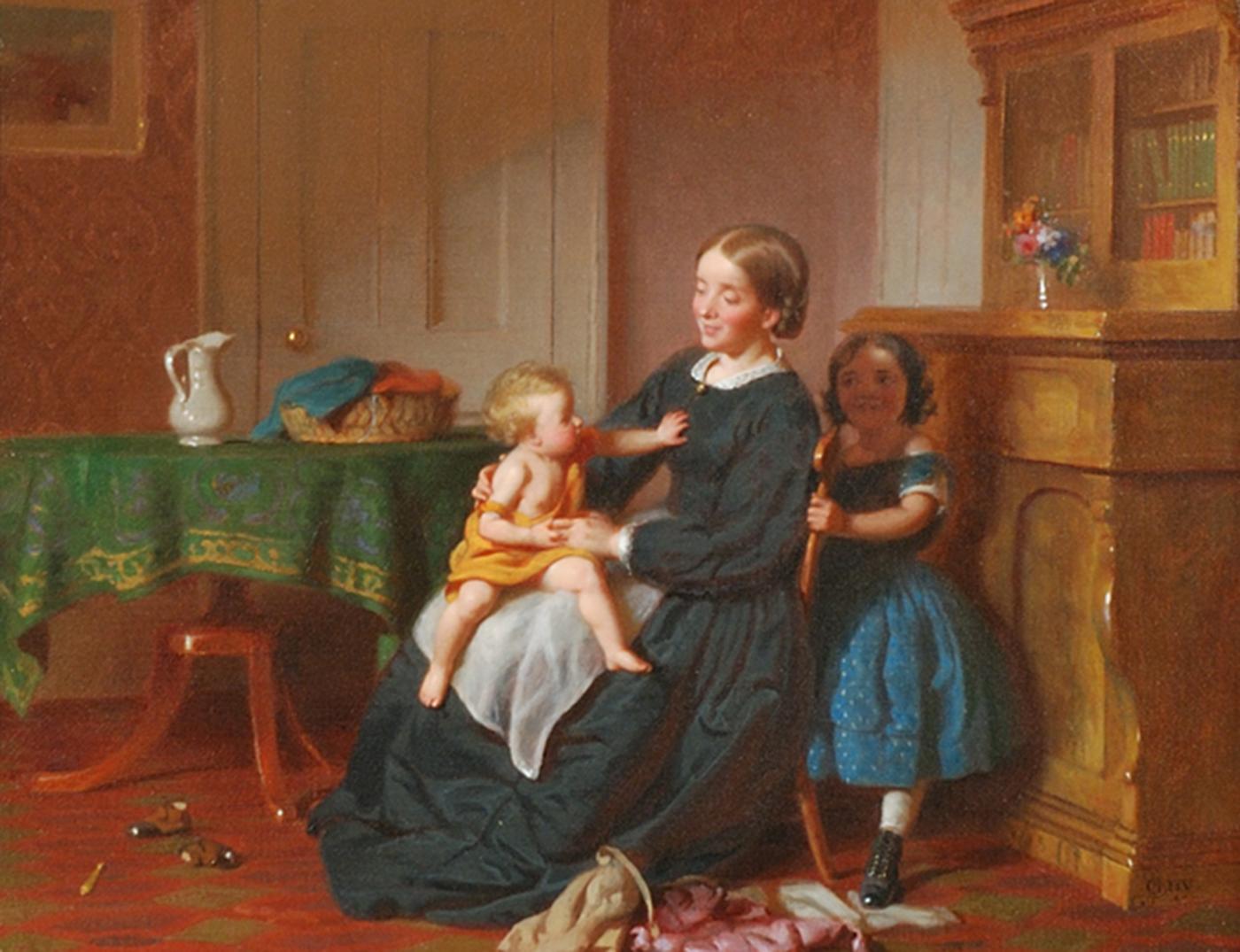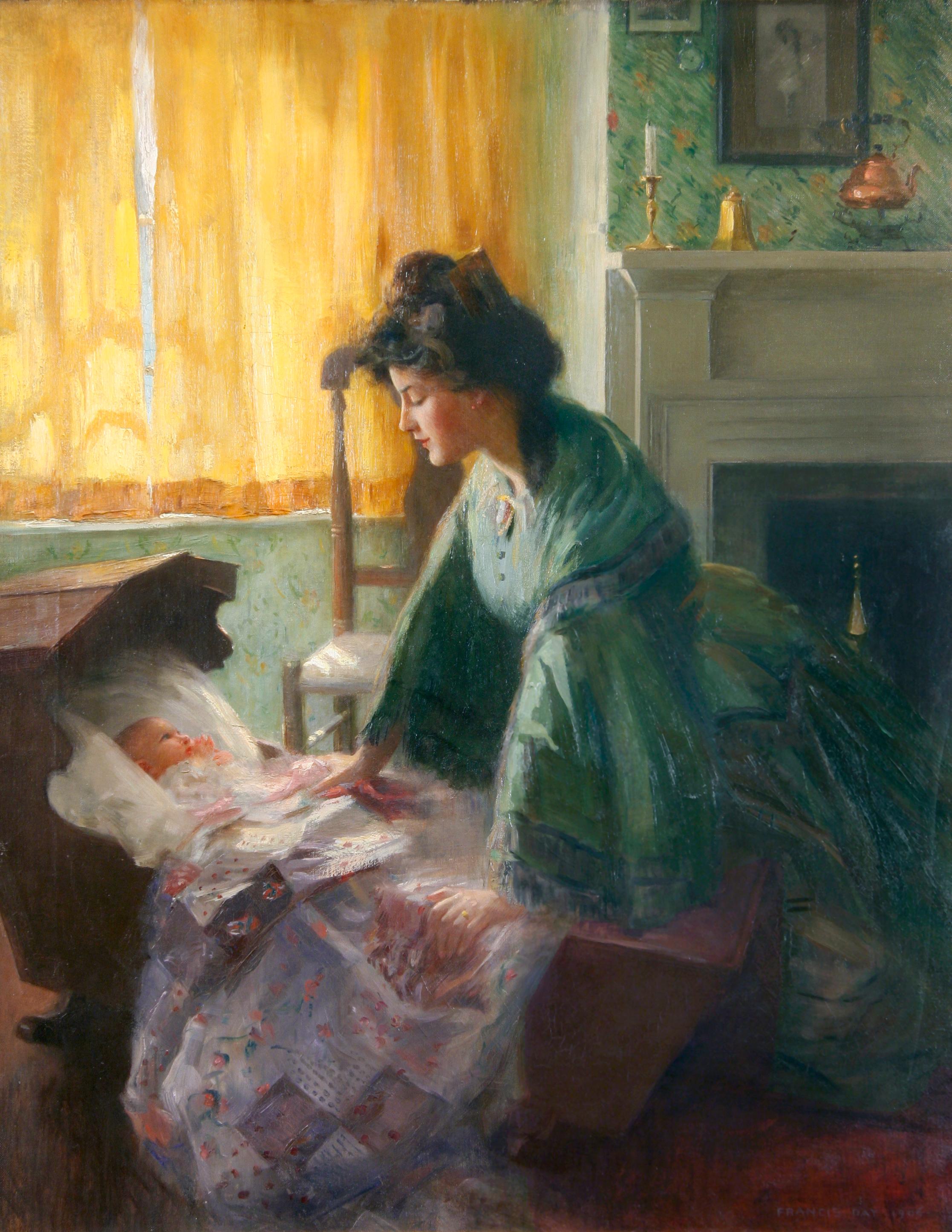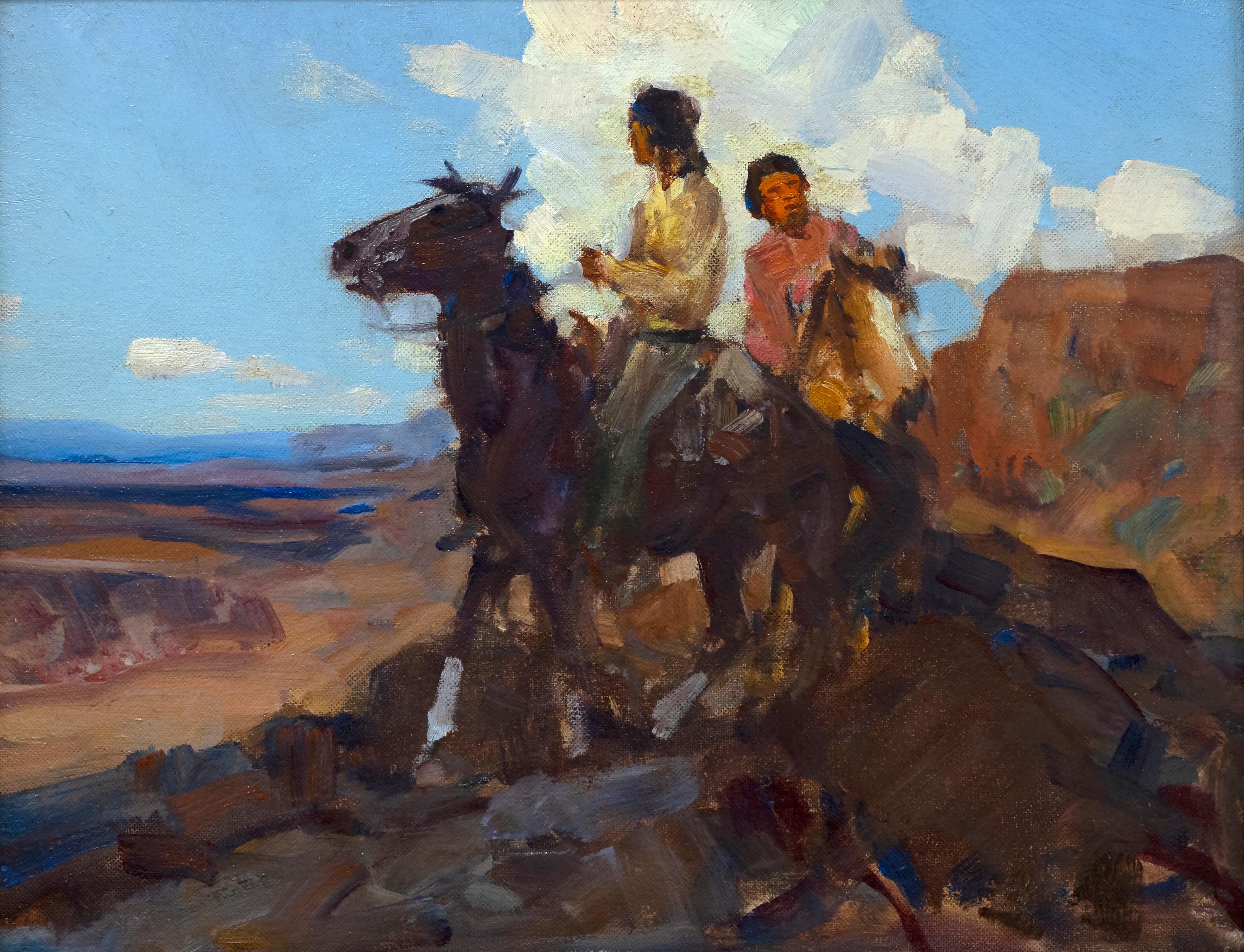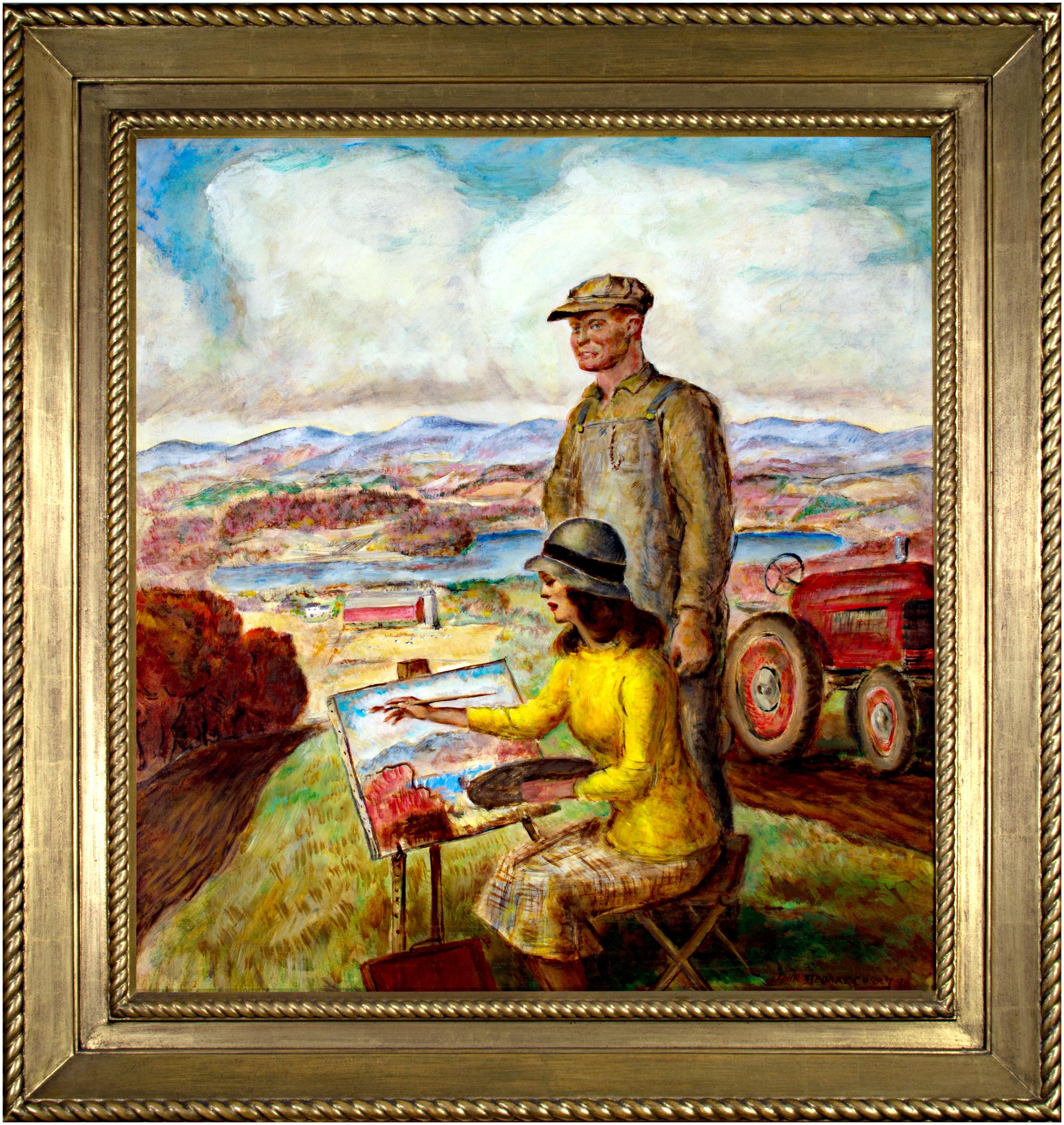Items Similar to The Race
Want more images or videos?
Request additional images or videos from the seller
1 of 8
William John HennessyThe Race 1860
1860
About the Item
William John Hennessy was born in Ireland. He came to America in 1849 with his mother and brother a year after his father had fled their homeland after taking part in the unsuccessful Young Ireland Party uprising. The Hennessys settled in New York, and when young William came of age, he decided upon a career as an artist. At the age of fifteen, he enrolled at the National Academy of Design, where he learned to draw from the antique, and the following year he was granted admission to the Academy’s life-drawing class.
Hennessy first exhibited at the National Academy in 1857, starting a continuous run of appearances in their annuals that lasted until 1870, when he expatriated himself to Europe. During his time in America, Hennessy was principally known as a genre painter and prolific illustrator for such publications as Harper’s Weekly and a number of books, including illustrated works of William Cullen Bryant, Henry Wadsworth Longfellow, and Alfred Lord Tennyson.
Hennessy left the United States and settled in London, living there and in its environs variously for a few years, and summered in Normandy, where he ultimately established a permanent residence in 1875. In 1893, Hennessy returned to England, but continued to spend a good deal of his time in France. Though the bulk of his career was spent abroad, Hennessy maintained a lifelong identification as an American, and exhibited with other American expatriates in both the Centennial Exposition, Philadelphia, in 1876, and also occasionally sent works to the National Academy’s annual exhibitions.
Few works by Hennessy are known today. From what one can glean from the surviving works, early on in his career, Hennessy appears to have concentrated on genre scenes and Barbizon-influenced landscapes, while in the late 1870s he appears to have adopted an more aestheticized style derived from Whistler and the English Pre-Raphaelites. His later works, from the mid-1890s on, show the strong influence of Impressionism.
Works by Hennessy are in public collections including The Metropolitan Museum of Art, New York; the Brooklyn Museum, New York; the Yale University Art Gallery, New Haven, Connecticut; the National Academy of Design, New York; the Mead Art Museum, Amherst College, Massachusetts; the Century Association, New York; and the Frances Lehman Loeb Art Center, Vassar College, Poughkeepsie, New York.
The present work, exhibited by the artist at the 1860 Annual Exhibition at the National Academy of Design, New York, as The Race, is a quintessential mid-century genre scene, a sure-fire winner for a young artist looking for an audience. In the center of the picture, Hennessy paints two adult passengers seated behind a driver in a sleigh drawn by a graceful prancing horse. A man and a woman, dressed for the occasion, are cushioned by what appears to be a fur wrap. The female wears a white fur bonnet and matching fur jacket, while the driver is amply protected from the cold by a hat with a wind visor and ear flaps, a high-collared vest, and gloved hands that hold his riding crop. Observing this elegant equipage, a group of four children in the foreground decide to test their own mobility against that of the horse and sleigh. A stylishly turned out-girl dressed in a fancy bonnet and red cape sits erect on a cushion on a child's sled, holding the railing and clutching her doll. The leads on her sled are held by an older boy who appears to be about to race against the horse-driven sleigh. While there is no guarantee that the girl on her sled is related to the adults, her elaborate outfit and china doll complexion suggest a link. The children in the picture are all appropriately dressed for the cold. A second pair of sledders, both young boys, watches the race. One boy holds two leads for another boy who sits on an improvised sled. Bare trees offer a winter landscape element for Hennessy, while in the background a small cityscape reveals three buildings including a church with a snowy spire and pitched roof lines. The overall composition evokes high spirits and bracing weather, a mythic look at winter in New York City with the nation on the brink of Civil War.
- Creator:William John Hennessy (1840 - 1917, British)
- Creation Year:1860
- Dimensions:Height: 18 in (45.72 cm)Width: 24.25 in (61.6 cm)
- Medium:
- Movement & Style:
- Period:
- Condition:
- Gallery Location:New York, NY
- Reference Number:
About the Seller
5.0
Recognized Seller
These prestigious sellers are industry leaders and represent the highest echelon for item quality and design.
Established in 1952
1stDibs seller since 2010
32 sales on 1stDibs
Associations
Art Dealers Association of America
- ShippingRetrieving quote...Ships From: New York, NY
- Return PolicyThis item cannot be returned.
More From This SellerView All
- Peek-a-BooBy Seymour Joseph GuyLocated in New York, NYIn the latter half of the nineteenth century and into the first decade of the twentieth, New York City art aficionados could count on finding recent work of Seymour Joseph Guy hanging on the walls of the city’s major galleries. Primarily a genre artist, but also a portraitist, between 1859 and 1908 Guy showed more than seventy works at the National Academy of Design. From 1871 to 1903 he contributed over seventy times to exhibitions at the Century Club. From 1864 to 1887, he sent about forty pictures to the Brooklyn Art Association. A good number of these works were already privately owned; they served as advertisements for other pictures that were available for sale. Some pictures were shown multiple times in the same or different venues. Guy was as easy to find as his canvases were omnipresent. Though he lived at first in Brooklyn with his family and then in New Jersey, from 1863 to his death in 1910 he maintained a studio at the Artist’s Studio Building at 55 West 10th Street, a location that was, for much of that period, the center of the New York City art world. Guy’s path to a successful career as an artist was by no means smooth or even likely. Born in Greenwich, England, he was orphaned at the age of nine. His early interest in art was discouraged by his legal guardian, who wanted a more settled trade for the young man. Only after the guardian also died was Guy free to pursue his intention of becoming an artist. The details of Guy’s early training in art are unclear. His first teacher is believed to have been Thomas Buttersworth...Category
19th Century American Realist Figurative Paintings
MaterialsCanvas, Oil
- Jardin des Tuileries, ParisBy Edmund QuincyLocated in New York, NYSigned (lower right): QuincyCategory
20th Century American Realist Figurative Paintings
MaterialsCanvas, Oil
- At the SpringBy Joshua ShawLocated in New York, NYJoshua Shaw was a farmer’s son, born in Billingborough, Lincolnshire, and orphaned at the age of seven. After a boyhood of privation, he tried a number of occupations, until he finally apprenticed to a sign painter and found his métier. Shaw went to Manchester to study art, and by 1802 was in Bath, painting landscapes. In that year he began to exhibit his work at the Royal Academy in London. Essentially self-taught, Shaw achieved an impressive level of competence and versatility, producing portraits, floral compositions, still lifes, landscapes, and, cattle pieces. Shaw continued to send works for exhibition at the Royal Academy, the British Institution, and the Suffolk Street Gallery, all in London, until 1841. (Although Shaw is regularly mentioned and frequently illustrated in a host of general books on American art history, as well as included in numerous historical survey exhibitions, the only monographic study of this artist is Miriam Carroll Woods, “Joshua Shaw [1776–1860]: A Study of the Artist and his Paintings” [M.A. thesis, University of California at Los Angeles, 1971]. Apart from short biographical sketches in various dictionaries and museum collection catalogues, the two most interesting references, both contemporary, are John Sartain’s personal recollections in The Reminiscences of a Very Old Man, 1808–1897 [1899; reprint 1969] and an article in Scientific American from August 7, 1869, “Joshua Shaw, Artist and Inventor.” The article quotes extensively from an autobiographical document in the possession of Shaw’s grandson that Shaw prepared for William Dunlap...Category
19th Century American Realist Landscape Paintings
MaterialsCanvas, Oil
- The GatewayBy Eleanor Parke CustisLocated in New York, NYSigned (lower right): ELEANOR PARKE CUSTISCategory
20th Century American Realist Landscape Paintings
MaterialsPaper, Gouache
- The Japanese CornerBy Elliott DaingerfieldLocated in New York, NYA child of the American South, Elliott Daingerfield was born in Harper’s Ferry, Virginia, and raised in Fayetteville, North Carolina, where his father, C...Category
19th Century American Impressionist Interior Paintings
MaterialsCanvas, Oil
- Splinters of a Secret Sky - SplintersBy Angela FraleighLocated in New York, NYSigned (on verso): AF/2021Category
2010s Contemporary Portrait Paintings
MaterialsCanvas, Acrylic Polymer, Oil, Acrylic
You May Also Like
- Light of LoveLocated in Washington, DCExhibited: National Academy of Design, New York, 1906 (as no. 101) Art Institute of Chicago, 1908 (as no. 74)Category
Early 1900s American Realist Figurative Paintings
MaterialsCanvas, Oil
- ScoutingBy Frank Tenney JohnsonLocated in Palm Desert, CA"Scouting" is an oil on canvas painting by Frank Tenney Johnson. The framed piece measures 23 3/4 x 27 3/4 x 3 1/4 inches. Johnson was well-known for his work of the American west, particularly for his portrayal of cowboys at night, lit by moonlight. Johnson utilized knives and fingers when painting, so his work is recognizable for its distinctive marks. Provenance: Biltmore Galleries, Scottsdale...Category
Early 20th Century American Realist Landscape Paintings
MaterialsCanvas, Oil
- 'Sketching Wisconsin' original oil painting, SignedBy John Steuart CurryLocated in Milwaukee, WIJohn Steuart Curry "Sketching Wisconsin," 1946 oil on canvas 31.13 x 28 inches, canvas 39.75 x 36.75 x 2.5 inches, frame Signed and dated lower right Overall excellent condition Presented in a 24-karat gold leaf hand-carved wood frame John Steuart Curry (1897-1946) was an American regionalist painter active during the Great Depression and into World War II. He was born in Kansas on his family’s farm but went on to study art in Chicago, Paris and New York as young man. In Paris, he was exposed to the work of masters such as Peter Paul Rubens, Eugène Delacroix and Jacques-Louis David. As he matured, his work showed the influence of these masters, especially in his compositional decisions. Like the two other Midwestern regionalist artists that are most often grouped with him, Grant Wood (American, 1891-1942) and Thomas Hart Benton (American, 1889-1975), Curry was interested in representational works containing distinctly American subject matter. This was contrary to the popular art at the time, which was moving closer and closer to abstraction and individual expression. Sketching Wisconsin is an oil painting completed in 1946, the last year of John Steuart Curry’s life, during which time he was the artist-in-residence at the University of Wisconsin in Madison. The painting is significant in Curry’s body of work both as a very revealing self-portrait, and as a landscape that clearly and sensitively depicts the scenery of southern Wisconsin near Madison. It is also a portrait of the artist’s second wife, Kathleen Gould Curry, and is unique in that it contains a ‘picture within a picture,’ a compositional element that many early painting masters used to draw the eye of the viewer. This particular artwork adds a new twist to this theme: Curry’s wife is creating essentially the same painting the viewer is looking at when viewing Sketching Wisconsin. The triangular composition of the figures in the foreground immediately brings focus to a younger Curry, whose head penetrates the horizon line and whose gaze looks out towards the viewer. The eye then moves down to Mrs. Curry, who, seated on a folding stool and with her hand raised to paint the canvas on the easel before her, anchors the triangular composition. The shape is repeated in the legs of the stool and the easel. Behind the two figures, stripes of furrowed fields fall away gently down the hillside to a farmstead and small lake below. Beyond the lake, patches of field and forest rise and fall into the distance, and eventually give way to blue hills. Here, Curry has subverted the traditional artist’s self-portrait by portraying himself as a farmer first and an artist second. He rejects what he sees as an elitist art world of the East Coast and Europe. In this self-portrait he depicts himself without any pretense or the instruments of his profession and with a red tractor standing in the field behind him as if he was taking a break from the field work. Here, Curry’s wife symbolizes John Steuart Curry’s identity as an artist. Compared with a self-portrait of the artist completed a decade earlier, this work shows a marked departure from how the artist previously presented and viewed himself. In the earlier portrait, Curry depicted himself in the studio with brushes in hand, and with some of his more recognizable and successful canvases behind him. But in Sketching Wisconsin, Curry has taken himself out of the studio and into the field, indicating a shift in the artist’s self-conception. Sketching Wisconsin’s rural subject also expresses Curry’s populist ideals, that art could be relevant to anyone. This followed the broad educational objectives of UW’s artist-in-residence program. Curry was appointed to his position at the University of Wisconsin in 1937 and was the first person to hold any such position in the country, the purpose of which was to serve as an educational resource to the people of the state. He embraced his role at the University with zeal and not only opened the doors of his campus studio in the School of Agriculture to the community, but also spent a great deal of time traveling around the state of Wisconsin to visit rural artists who could benefit from his expertise. It was during his ten years in the program that Curry was able to put into practice his belief that art should be meaningful to the rural populace. However, during this time he also struggled with public criticism, as the dominant forces of the art market were moving away from representation. Perhaps it was Curry’s desire for public acceptance during the latter part of his career that caused him to portray himself as an Everyman in Sketching Wisconsin. Beyond its importance as a portrait of the artist, Sketching Wisconsin is also a detailed and sensitive landscape that shows us Curry’s deep personal connection to his environment. The landscape here can be compared to Wisconsin Landscape of 1938-39 (the Metropolitan Museum of Art), which presents a similar tableau of rolling hills with a patchwork of fields. Like Wisconsin Landscape, this is an incredibly detailed and expressive depiction of a place close to the artist’s heart. This expressive landscape is certainly the result of many hours spent sketching people, animals, weather conditions and topography of Wisconsin as Curry traveled around the state. The backdrop of undulating hills and the sweeping horizon, and the emotions evoked by it, are emphatically recognizable as the ‘driftless’ area of south-central Wisconsin. But while the Metropolitan’s Wisconsin Landscape conveys a sense of uncertainty or foreboding with its dramatic spring cloudscape and alternating bands of light and dark, Sketching Wisconsin has a warm and reflective mood. The colors of the foliage indicate that it is late summer and Curry seems to look out at the viewer approvingly, as if satisfied with the fertile ground surrounding him. The landscape in Sketching Wisconsin is also revealing of what became one of Curry’s passions while artist-in-residence at UW’s School of Agriculture – soil conservation. When Curry was a child in Kansas, he saw his father almost lose his farm and its soil to the erosion of The Dust Bowl. Therefore, he was very enthusiastic about ideas from UW’s School of Agriculture on soil conservation methods being used on Wisconsin farms. In Sketching Wisconsin, we see evidence of crop rotation methods in the terraced stripes of fields leading down the hillside away from the Curry’s and in how they alternate between cultivated and fallow fields. Overall, Sketching Wisconsin has a warm, reflective, and comfortably pastoral atmosphere, and the perceived shift in Curry’s self-image that is evident in the portrait is a positive one. After his rise to favor in the art world in the 1930’s, and then rejection from it due to the strong beliefs presented in his art, Curry is satisfied and proud to be farmer in this self-portrait. Curry suffered from high blood...Category
1940s American Realist Figurative Paintings
MaterialsOil, Canvas
- Antique American Oil Painting Portrait Young Woman Necklace Period Frame RareLocated in Buffalo, NYA beautiful and rare antique American portrait of a young woman in a stunning period frame, likely original to the piece. Unsigned but beaut...Category
1890s American Realist Portrait Paintings
MaterialsOil, Canvas
- VictoryLocated in Ibadan, Oyo"Victory" emanates a sense of vibrancy and vitality, drawing viewers into its world of anticipation and celebration. The central figure, depicted with a wide grin and laughter lines ...Category
21st Century and Contemporary American Realist Mixed Media
MaterialsCanvas, Mixed Media, Oil, Acrylic
- America 2017, New York, urban architecture, subtle colorBy Gregory FruxLocated in Brooklyn, NYOil on canvas Dr. Rowland S. Russell PhD. writes about his experience directly witnessing Greg's practice as a “plein air” artist: Whether he’s portraying quiet scenes from Brooklyn...Category
2010s American Realist Landscape Paintings
MaterialsOil, Canvas




